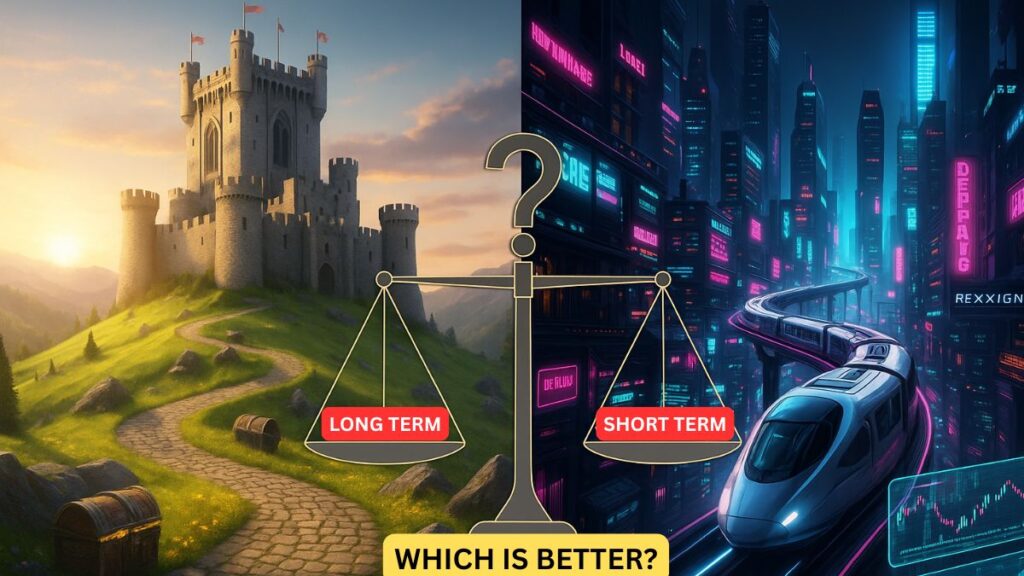Long Term vs Short Term Investing: Which Strategy Is Better for You?
When it comes to investing, one of the biggest decisions every investor faces is whether to go long-term or short-term. In this article, we will elucidate the definitions of long-term and short-term investing, examine their respective advantages and disadvantages, and provide guidance on determining the most suitable strategy for your circumstances.
Table of Contents
What Is Long-Term Investing?
Long-term investing is a strategy in which investors acquire and retain assets for a prolonged duration, generally five years or more, to attain consistent growth and accumulate wealth over time.
Long-term investors trust in the efficacy of compounding — a process where profits are reinvested to yield even greater returns.
This method enables investments to expand gradually, frequently surpassing the performance of short-term trading in the long term.
The objective is to incrementally build wealth by permitting your assets to flourish through compounding returns.
Key Features of Long-Term Investing:
Time Horizon: Generally 5 to 10 years or more.
Goal: Wealth accumulation, retirement funding, or achieving financial independence.
Approach: Acquire quality assets and maintain them through market fluctuations.
Mindset: Emphasizes patience, consistency, and long-term financial objectives.
Examples of Long-Term Investments:
a. Stocks of well-established companies (Blue-chip stocks)
b. Mutual funds and index funds
c. Retirement plans (SIP, PPF, or 401(k))
d. Real estate investments
e. Gold or ETFs held for extended periods.
Benefits of Long-Term Investing:
Compounding Returns: The longer you remain invested, the higher your potential returns.
Lower Taxes: Long-term capital gains typically enjoy reduced tax rates.
Reduced Stress: There is no necessity to track daily market fluctuations.
Wealth Building: Optimal for achieving significant financial objectives over time.
Risks of Long-Term Investing:
a. Market declines can temporarily diminish portfolio value.
b. It necessitates patience — outcomes are not immediate.
c. Inflation may erode returns if investments do not perform adequately.
Example:
If you invest ₹1,00,000 in a mutual fund yielding 10% annually and retain it for 10 years, it will grow to approximately ₹2,59,000 — all due to compounding.
What Is Short-Term Investing?
Short-term investing refers to a strategy aimed at achieving rapid profits within a brief period — typically ranging from a few days to several months, and seldom extending beyond one year.
In contrast to long-term investors who retain assets for extended durations, short-term investors seek to take advantage of market fluctuations and price variations to yield swift returns. This approach is frequently employed by active traders who diligently observe market trends, technical indicators, and global developments to make prompt buy-and-sell choices.
Key Features of Short-Term Investing:
Time Horizon: Spans from a few days to 12 months.
Goal: To secure quick profits from transient market movements.
Approach: Engaging in active trading and frequent portfolio modifications.
Mindset: Concentrated on market timing and capitalizing on immediate opportunities.
Examples of Short-Term Investments:
a. Stock trading or day trading
b. Swing trading (holding for several days or weeks)
c. Forex or cryptocurrency trading
d. Short-term bonds and ETFs
e. Arbitrage and futures contracts
Benefits of Short-Term Investing:
Quick Returns: The potential to realize profits within weeks or months.
High Liquidity: Investments can be readily converted into cash.
Active Control: Investors can swiftly respond to market fluctuations.
Opportunities in Volatile Markets: Short-term traders can gain from frequent price oscillations.
Risks of Short-Term Investing:
High Volatility: Abrupt market shifts can result in considerable losses.
Higher Taxes: Short-term profits are subject to higher tax rates compared to long-term gains.
Time-Consuming: Necessitates ongoing analysis, monitoring, and decision-making.
Emotional Stress: Constant market fluctuations can lead to hasty trading decisions.
Example: Imagine purchasing a stock at ₹1,000 and selling it a week later at ₹1,100 — you achieve a 10% return in just a few days.
Conversely, if the stock price declines to ₹950 instead, you incur a 5% loss during the same timeframe.
This illustrates the trade-off inherent in short-term investing — the potential for high rewards accompanied by significant risks.
Long Term vs Short Term: Key Differences
| Factor | Long-Term Investing | Short-Term Investing |
|---|---|---|
| Time Horizon | 5+ years | Days to months |
| Risk Level | Lower | Higher |
| Returns | Steady and consistent | Fast but uncertain |
| Tax Impact | Lower long-term tax | Higher short-term tax |
| Ideal For | Wealth builders, retirement planners | Active traders, quick-profit seekers |
| Market Monitoring | Minimal | Frequent |
Final Thoughts
Both long-term and short-term investment strategies can yield profits when applied judiciously.
If your objective is to achieve consistent growth with reduced risk, long-term investing is frequently the more advantageous route.
Conversely, if you possess the requisite time, expertise, and willingness to take risks, short-term investing may offer thrilling prospects for quicker returns. The essential factor is to develop a strategy that corresponds with your financial objectives, investment timeline, and risk tolerance.
📌 FAQ Section
Which gives better returns: long-term or short-term investing?
A: Typically, long-term investments tend to offer more consistent and elevated returns over time as a result of compounding. In contrast, short-term investments may generate profits but are associated with greater risk.
Can I do both long-term and short-term investing?
A: Yes, a mixed strategy can balance stability (long-term) and flexibility (short-term).
Is long-term investing safer than short-term?
A: In most cases, yes. Long-term investments are generally less susceptible to the fluctuations of short-term market volatility.
Is short-term investing safe?
A: Not always — it carries higher risks due to market volatility.
